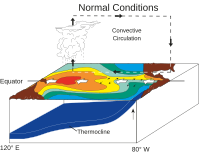
Photo from wikipedia
Much of the previous research on total and heavy precipitation trends across the Northeastern US (hereafter Northeast) used daily precipitation totals over relatively short periods of record, which do not… Click to show full abstract
Much of the previous research on total and heavy precipitation trends across the Northeastern US (hereafter Northeast) used daily precipitation totals over relatively short periods of record, which do not capture the full range of climate variability and change. Less well understood are the characteristics of long-term changes and synoptic patterns in longer-duration heavy precipitation events across the Northeast. A multi-duration (1, 2, 3, 7, 14, and 30 days), multi-return interval (2, 5, 10, and 50 years) precipitation dataset was used to diagnose changes in various types of precipitation events across the Northeast from 1895 to 2017. Increasing trends were found in all duration and return-interval event combinations with the rarest, longest duration events increasing at faster rates than more frequent, shorter duration ones. Daily 850-hPa geopotential height patterns associated with precipitation events were extracted from Rotated Principal Component Analysis and k-means clustering analysis, which allowed for the main synoptic types present, as well as their structure and evolution to be analyzed. The daily synoptic patterns thus identified were found to be similar across all durations and return-intervals and included: coastal low (Nor’easters, tropical cyclones, and predecessor rain events), deep trough, east coast trough, zonal, and high pressure patterns.
Journal Title: Journal of Applied Meteorology and Climatology
Year Published: 2023
Link to full text (if available)
Share on Social Media: Sign Up to like & get
recommendations!